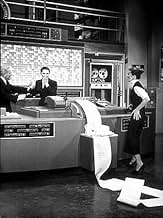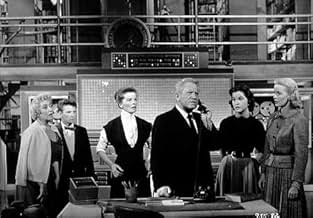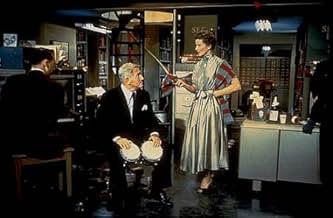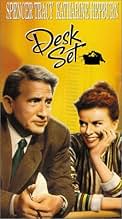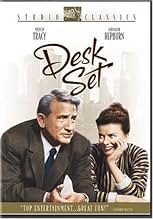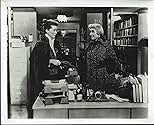IMDb रेटिंग
7.2/10
10 हज़ार
आपकी रेटिंग
अपनी भाषा में प्लॉट जोड़ेंTwo extremely strong personalities clash over the computerization of a television network's research department.Two extremely strong personalities clash over the computerization of a television network's research department.Two extremely strong personalities clash over the computerization of a television network's research department.
- निर्देशक
- लेखक
- स्टार
Pamela Curran
- Bit Part
- (बिना क्रेडिट के)
Bill Duray
- Member of the Board
- (बिना क्रेडिट के)
Harry Evans
- Member of the Board
- (बिना क्रेडिट के)
Jesslyn Fax
- Mrs. Hewitt
- (बिना क्रेडिट के)
Richard Gardner
- Fred
- (बिना क्रेडिट के)
फ़ीचर्ड समीक्षाएं
Desk Set is a lighthearted, delightful, and thoroughly enjoyable watch courtesy of the effervescent chemistry between one of hollywoods greatest pairings Tracy and Hepburn. Surprisingly, Desk Set, despite its themes about automation and technology, still holds up decently well today, for it realises the power of context and human intuition lacking in any machine(though I might hesitate in saying the same thing in twenty years time given how rapidly technology is advancing). The highlight of Desk Set is of course the sparkling chemistry between Hepburn and Tracy. Hepburn is superb as the assertive, strong willed, sharp minded Bunny, stuck in a relationship with an always missing Mike Cutler, while Tracy plays the very affable Richard, who is self assured of his intellect, and as a result has an air of confidence around him, as if he were always in control of any situation. There is also a wonderful dynamic and camaraderie in the research department, consisting of three other characterful ladies which adds a great deal of charm to the picture. The script is also mildly witty, definitely sharper than the average rubbish around nowadays. Indeed, the film remains a breezy watch, that I cannot find much fault with it. It has an endearing storyline with well written characters that are never too serious. The film may not provide for many hysterical laughs but it does allow for plenty of chuckles. My only objection may be that it slows down in the second half, and the romance between Hepburns and Tracy's character could have been further developed. Regardless, I have to say Desk set is a remarkably fun office Romcom providing some laughs, and a charming office atmosphere which should easily hold an Audiences attention through its runtime. A thoroughly enjoyable watch.
Desk Set was the next to last teaming of Tracy and Hepburn and the first one away from MGM. It does have a different look to the product they did at MGM. Still good, but different. Probably because this was done in Cinemascope and Technicolor.
Hard to believe that Cinemascope would be used on a film essentially set indoors and on one set, the set being Hepburn's office. But that was to show the immense size of Emirac the giant computer being installed there which Katharine and her staff think is going to replace them.
Desk Set had been on Broadway two year ago and had a respectable run. It starred Shirley Booth in Katharine Hepburn's part and the rest of the cast were not names by any means. I'm sure Spencer Tracy's role had to be built up from the stage version.
Even so, the film is essentially Hepburn's. As usual in their films she has a rival to Tracy. In the past that part was played by such people as Melvyn Douglas, David Wayne, William Ching, and now Gig Young. It seemed like every movie comedy in the late 50s and early 60s had either Young or Tony Randall as the defeated rival role. Young gives his patented performance here.
A running gag throughout the film are the calls handled by Hepburn's staff at the broadcast network for inane information. Like someone up in the corporate headquarters is playing trivial pursuit.
Also look for good performances by Joan Blondell, Sue Randall, and Dina Merrill as Hepburn's staff and Neva Patterson as Emirac's installer and keeper.
A good addition to the Tracy-Hepburn pantheon.
Hard to believe that Cinemascope would be used on a film essentially set indoors and on one set, the set being Hepburn's office. But that was to show the immense size of Emirac the giant computer being installed there which Katharine and her staff think is going to replace them.
Desk Set had been on Broadway two year ago and had a respectable run. It starred Shirley Booth in Katharine Hepburn's part and the rest of the cast were not names by any means. I'm sure Spencer Tracy's role had to be built up from the stage version.
Even so, the film is essentially Hepburn's. As usual in their films she has a rival to Tracy. In the past that part was played by such people as Melvyn Douglas, David Wayne, William Ching, and now Gig Young. It seemed like every movie comedy in the late 50s and early 60s had either Young or Tony Randall as the defeated rival role. Young gives his patented performance here.
A running gag throughout the film are the calls handled by Hepburn's staff at the broadcast network for inane information. Like someone up in the corporate headquarters is playing trivial pursuit.
Also look for good performances by Joan Blondell, Sue Randall, and Dina Merrill as Hepburn's staff and Neva Patterson as Emirac's installer and keeper.
A good addition to the Tracy-Hepburn pantheon.
It comes as no surprise that the 30-second attention span generation finds this jewel a little dull. There is no quick-cut music video cinematography. The characters are all actually old enough to be believable in their roles. which are not based on clothing or haircuts. It depends on talent rather than hype. And most of all, it is far too intelligent, witty and literate for today's garbage-numbed Philistine.
The story is simple, as all good stories are. Hepburn feels her job, and those of her staff, are threatened by Tracy and his ominous computer. It may not sound like much in this day of computer ubiquity, but substitute dot.com flop or outsourcing for computer and you have a contemporary comedy that still works.
Let's ignore the leads for just a moment. The supporting cast, which includes Joan Blondell as the arch-typical right-hand man, or should I say woman, and Gig Young as the chauvinistic, corporate climbing fiancé, easily outclasses what passes for marquee stars today. Husband and wife team Henry and Phoebe Ephron, parents of Nora Ephron, contribute a brilliantly witty script that, unfortunately for modern moviegoers, isn't peppered with vaudevillian pratfalls to help point out the funny parts. Instead, it relies on the intelligence of the audience and draws on that of the cast to produce a humor that never ages.
Hepburn is almost universally considered the greatest film actress ever. Tracy is utterly magnificent, and the chemistry between the two of them, owing of course in part to their long-standing relationship, is palpable.
I adore this movie, and if there were a Canon of Cinema, this would be in it.
The story is simple, as all good stories are. Hepburn feels her job, and those of her staff, are threatened by Tracy and his ominous computer. It may not sound like much in this day of computer ubiquity, but substitute dot.com flop or outsourcing for computer and you have a contemporary comedy that still works.
Let's ignore the leads for just a moment. The supporting cast, which includes Joan Blondell as the arch-typical right-hand man, or should I say woman, and Gig Young as the chauvinistic, corporate climbing fiancé, easily outclasses what passes for marquee stars today. Husband and wife team Henry and Phoebe Ephron, parents of Nora Ephron, contribute a brilliantly witty script that, unfortunately for modern moviegoers, isn't peppered with vaudevillian pratfalls to help point out the funny parts. Instead, it relies on the intelligence of the audience and draws on that of the cast to produce a humor that never ages.
Hepburn is almost universally considered the greatest film actress ever. Tracy is utterly magnificent, and the chemistry between the two of them, owing of course in part to their long-standing relationship, is palpable.
I adore this movie, and if there were a Canon of Cinema, this would be in it.
This comedy keeps turning on cable any now and then. When faced with the prospect of watching substandard fare, the clear choice is to go to something that is amusing, as well as to entertaining, which is why "Desk Set" is a good bet to watch.
"Desk Set", directed by Walter Lang, evokes those bygone years before automation and the arrival of the computers into one's life. The comedy, adapted from the stage with great care by Henry and Phoebe Ephron, accomplishes all the requisites for a nice way to spend a couple of hours.
The time is the late 50s in Manhattan. The cost controlling expert, Richard Sumner, is hired to make changes in the way the New York firm can cut costs in all areas of business. Mr. Sumner's solution is to start automation in several areas, such as in the payroll department. He faces a formidable task when he takes to task making the research department more efficient, in the days before Google.
Mr. Sumner has to deal with the smart Bunny Watson, who has more facts and figures at her fingertips than any contraption could find at any given moment. Thus begins a tug of war between the man who is perceived as the "terminator of jobs" and the four women in research. They'll teach him a thing, or two.
The best part of the film is the interplay between the two principals, Spencer Tracy and Katherine Hepburn. Its a tribute to them, as actors, they could work so well together. Also, toward the end of the movie, at the company's Christmas party, we see a playful, and drunk Bunny singing Cole Porter's "Night and Day" to the beat of the bongo playing of Richard Sumner. That scene shows a playful Katherine Hepburn having a great time in front of the cameras.
This delicious movie will certainly please anyone looking for a good time. Ms. Hepburn does excellent work as the spinsterish Bunny. Mr. Tracy is equally her match as the efficiency expert who is not in touch with reality.
The women in the research department, Joan Blondell, Dina Merrill and Sue Radall, are quite good. Gig Young has the thankless task of being a man interested in Katherine Hepburn, when it's obvious her heart clearly belongs to Spencer Tracy.
Enjoy the movie, but better yet, enjoy the magic created by Kate and Spencer!
"Desk Set", directed by Walter Lang, evokes those bygone years before automation and the arrival of the computers into one's life. The comedy, adapted from the stage with great care by Henry and Phoebe Ephron, accomplishes all the requisites for a nice way to spend a couple of hours.
The time is the late 50s in Manhattan. The cost controlling expert, Richard Sumner, is hired to make changes in the way the New York firm can cut costs in all areas of business. Mr. Sumner's solution is to start automation in several areas, such as in the payroll department. He faces a formidable task when he takes to task making the research department more efficient, in the days before Google.
Mr. Sumner has to deal with the smart Bunny Watson, who has more facts and figures at her fingertips than any contraption could find at any given moment. Thus begins a tug of war between the man who is perceived as the "terminator of jobs" and the four women in research. They'll teach him a thing, or two.
The best part of the film is the interplay between the two principals, Spencer Tracy and Katherine Hepburn. Its a tribute to them, as actors, they could work so well together. Also, toward the end of the movie, at the company's Christmas party, we see a playful, and drunk Bunny singing Cole Porter's "Night and Day" to the beat of the bongo playing of Richard Sumner. That scene shows a playful Katherine Hepburn having a great time in front of the cameras.
This delicious movie will certainly please anyone looking for a good time. Ms. Hepburn does excellent work as the spinsterish Bunny. Mr. Tracy is equally her match as the efficiency expert who is not in touch with reality.
The women in the research department, Joan Blondell, Dina Merrill and Sue Radall, are quite good. Gig Young has the thankless task of being a man interested in Katherine Hepburn, when it's obvious her heart clearly belongs to Spencer Tracy.
Enjoy the movie, but better yet, enjoy the magic created by Kate and Spencer!
On my first viewing of this movie, I didn't particularly like it. I was surprised that Tracy and Hepburn filmed this movie at all. But then, I re-watched it recently during the AMC tribute to the late great Kate. On second viewing, I found a lot about it endearing and quite humorous.
Although the technology is antiquated, the reaction to change in an organization is not. Speaking from an EEO perspective, Hepburn's boyfriend would be a sexual harassment suit waiting to happen in today's world. However, the office politics are identical to the office politics today. Instead of using the telephone to gossip, people in the office now use email.
Tracy and Hepburn gave great performances in this light-hearted romantic comedy. The scene in Hepburn's apartment is hilarious. Her reaction to her boyfriend's suggestion that he thought she would be alone is priceless. And, when Tracy stumbles out, we get to see Hepburn's uncontrollable laughter (that was probably not scripted) which always makes me lol.
So, take a second look if you first didn't like this movie.
Although the technology is antiquated, the reaction to change in an organization is not. Speaking from an EEO perspective, Hepburn's boyfriend would be a sexual harassment suit waiting to happen in today's world. However, the office politics are identical to the office politics today. Instead of using the telephone to gossip, people in the office now use email.
Tracy and Hepburn gave great performances in this light-hearted romantic comedy. The scene in Hepburn's apartment is hilarious. Her reaction to her boyfriend's suggestion that he thought she would be alone is priceless. And, when Tracy stumbles out, we get to see Hepburn's uncontrollable laughter (that was probably not scripted) which always makes me lol.
So, take a second look if you first didn't like this movie.
क्या आपको पता है
- ट्रिवियाImprovised Scene: Sumner is leaving Bunny's apartment, shortly after Mike leaves and Peg arrives, when Bunny and Sumner are recapping the afternoon's events for Peg. Sumner puts on the ruined shoes and grimaces as he tries to walk in them, which causes Bunny to laugh. He hobbles off stage and returns with his hat pulled down over his ears, his shirt dangling out of his pants, staggering as though drunk and talking crazy. This moment, including the women's hysterical laughter and Katharine Hepburn's nearly falling out of her chair, is spontaneous and not in the script.
- गूफ़In the opening shot of the film at Rockefeller Center, the shot begins at ground level and tilts up the building, but it was clearly shot from the top of the building down to ground level and then reversed because all the people on the ground are walking backwards.
- भाव
[Sumner answers the phone while the girls are at a Christmas party]
Richard Sumner: Hello? Santa Claus's reindeer? Uh, why yes I can... let's see, there's Dopey, Sneezy, Grouchy, Happy, Sleepy, uh Rudolph, and Blitzen! You're welcome!
- क्रेज़ी क्रेडिटOpening credits: "The filmmakers gratefully acknowledge the cooperation and assistance of the International Business Machines Corporation."
- कनेक्शनFeatured in 20th Century-Fox: The First 50 Years (1997)
- साउंडट्रैकHark! The Herald Angels Sing
(uncredited)
Music by Felix Mendelssohn
Lyrics by Charles Wesley
Sung by a chorus during the shot of the Rockefeller Center Christmas tree
टॉप पसंद
रेटिंग देने के लिए साइन-इन करें और वैयक्तिकृत सुझावों के लिए वॉचलिस्ट करें
- How long is Desk Set?Alexa द्वारा संचालित
विवरण
- चलने की अवधि
- 1 घं 43 मि(103 min)
- रंग
- ध्वनि मिश्रण
- पक्ष अनुपात
- 2.35 : 1
इस पेज में योगदान दें
किसी बदलाव का सुझाव दें या अनुपलब्ध कॉन्टेंट जोड़ें


